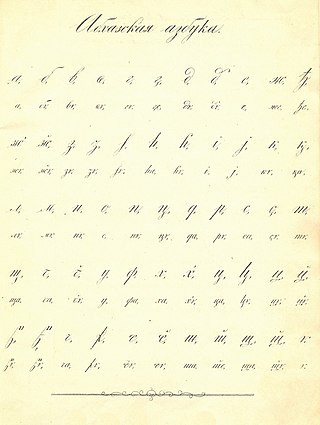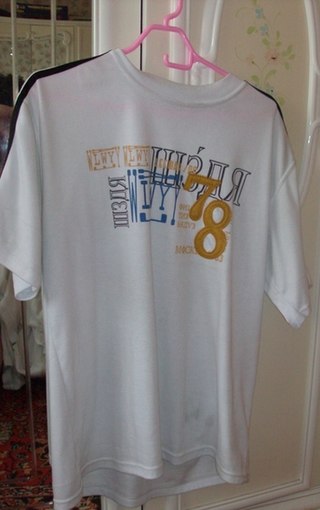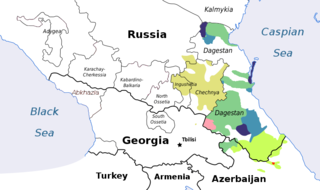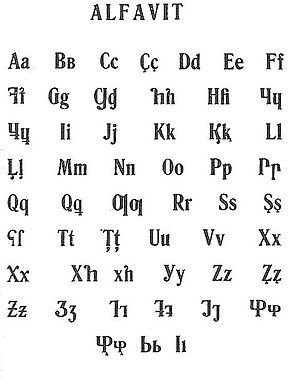E, or e, is the fifth letter and the second vowel letter of the Latin alphabet, used in the modern English alphabet, the alphabets of other western European languages and others worldwide. Its name in English is e ; plural es, Es or E's.

The Abkhaz alphabet is a Cyrillic alphabet used for the Abkhaz language.

Adyghe is a Northwest Caucasian language spoken by the western subgroups of Circassians. It is spoken mainly in Russia, as well as in Turkey, Jordan, Syria and Israel, where Circassians settled after the Circassian genocide by the Russians. It is closely related to the Kabardian language, though some reject the distinction between the two languages in favor of both being dialects of a unitary Circassian language.

Eng or engma is a letter of the Latin alphabet, used to represent a voiced velar nasal in the written form of some languages and in the International Phonetic Alphabet.

Faux Cyrillic, pseudo-Cyrillic, pseudo-Russian or faux Russian typography is the use of Cyrillic letters in Latin text, usually to evoke the Soviet Union or Russia, though it may be used in other contexts as well. It is a common Western trope used in book covers, film titles, comic book lettering, artwork for computer games, or product packaging which are set in or wish to evoke Eastern Europe, the Soviet Union, or Russia. A typeface designed to emulate Cyrillic is classed as a mimicry typeface.

Esh is a character used in phonology to represent the voiceless postalveolar fricative.
The Common Turkic alphabet is a project of a single Latin alphabet for all Turkic languages based on a slightly modified Turkish alphabet, with 34 letters recognised by the Organization of Turkic States. Its letters are as follows:

Latin alpha, script a, or single-story a, is a letter of the Latin alphabet based on one lowercase form of a, or on the Greek lowercase alpha (α).

Lak is a Northeast Caucasian language forming its own branch within this family. It is the language of the Lak people from the Russian autonomous republic of Dagestan, where it is one of six standardized languages. It is spoken by about 157,000 people.

The Belarusian Arabic alphabet or Belarusian Arabitsa was based on the Arabic script and was developed in the 16th century. It consisted of twenty-eight graphemes, including several additions to represent Belarusian phonemes not found in the Arabic language.

En with hook is a letter of the Cyrillic script. Its form is derived from the Cyrillic letter En (Н н) by adding a hook to the right leg.

There are 4 stages in the history of Yakut writing systems:

With the adoption of letters from the International Phonetic Alphabet (IPA) in various national alphabets, letter case forms have been developed. This usually means capital (uppercase) forms were developed, but in the case of the glottal stop, both uppercase ⟨Ɂ⟩ and lowercase ⟨ɂ⟩ are used.

Turned H is an additional letter of the Latin alphabet, based on a turned form of H. It is used in the Dan language in Liberia. Its lowercase form is used in the International Phonetic Alphabet to represent the voiced labial–palatal approximant. It was also historically used in the Abaza, Abkhaz, and the Vassali Maltese alphabet.

Latin yeru or I with bowl is an additional letter of the Latin alphabet based on the Cyrillic soft sign. It was introduced in 1928 into the reformed Yañalif, and later into other alphabets for Soviet minority languages. The letter was designed specifically to represent the non-front close vowel sounds IPA:[ɨ] and IPA:[ɯ]. Thus, this letter corresponds to the letter ⟨I ı⟩ in modern Turkic alphabets, and the letter yery in Cyrillic.

Reversed F is an additional letter of Latin writing used in epigrahic inscriptions to abbreviate the words filia or femina. It was also formerly used in the writing of the Abaza, the Abkhaz, the Adyghe and the Kabardian languages in the 1920s and 1930s.

H with left hook is an additional letter of the Latin script which was used in the writing of the Abaza and the Kabardian languages in the 1920s and was proposed for the writing of the Sotho-Tswana language in 1929.

Turned H with stroke or turned h with stroke at descender is a letter of the Latin script which was used in the orthographies of the Abkhaz and the Abaza languages.
This page is based on this
Wikipedia article Text is available under the
CC BY-SA 4.0 license; additional terms may apply.
Images, videos and audio are available under their respective licenses.

![]() ,
, ![]() ) is an additional letter of the Latin script which was used in the writing of the Abkhaz language from 1928 to 1938, in the Abaza language, in the Kabardian language, in the Shiddin language and in the Udi language.
) is an additional letter of the Latin script which was used in the writing of the Abkhaz language from 1928 to 1938, in the Abaza language, in the Kabardian language, in the Shiddin language and in the Udi language.

















